Contents
- Benefits of keeping bees in Dadany
- Classification of hives Dadan
- Device hives Dadan
- Do-it-yourself Dadan hive for 8 frames
- How to make a 10-frame hive Dadan
- Do-it-yourself Dadanovsky 12-frame hive
- Drawings and dimensions of the 14-frame hive Dadan
- 16-frame hive Dadan: dimensions and drawings
- Drawings and dimensions of the dadan frame
- Conclusion
The size drawings of the 12-frame hive Dadan are most often of interest to beekeepers because of the versatility of the design. Among the variety of models, the house occupies the middle ground in terms of size and weight. There are hives for fewer frames, but they are not always practical. Large models for 14 and 16 frames are convenient for receiving large bribes. However, it is difficult to carry such hives.
Benefits of keeping bees in Dadany
The design of the Dadan hives is considered outdated, but is still popular with many amateur beekeepers. The fact is explained by a number of advantages:
- spacious housing is convenient for accommodating a large bee colony;
- in the hive in winter, you can keep two bee colonies, separated by a partition;
- thoughtful design of the hive reduces the likelihood of swarming;
- simplified access to frames and honeycombs located in one place;
- to expand the space for bees or honey frames, the hive is supplemented with buildings and shops;
- a single-hull hive is multifunctional, which saves the beekeeper from unnecessary work with the housings.
Despite the fact that the model is outdated, there are always frames, spare cases and other parts for sale for Dadan hives.
Classification of hives Dadan
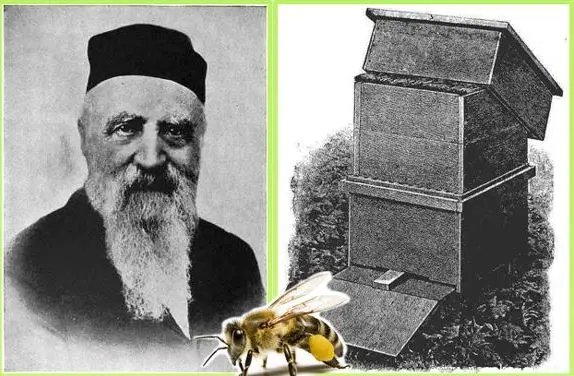
By design, Dadan hives are divided into single-hull and multi-hull models. The following types are distinguished by dimensions:
- a non-standard design is an 8-frame house, which is rare among amateur beekeepers;
- among beekeepers for 10 frames, the Dadan hive is considered a classic;
- a 12-frame house has a square shape, allowing you to put frames on a warm and cold skid;
- hives for 14 and 16 frames are bulky and heavy, more suitable for stationary apiaries.
A Frenchman by origin, Charles Dadan is considered the first creator of beehives, where you can vertically arrange the bee colony. For improvement, the beekeeper chose an 8-frame house, converting it to 12 Quimby frames.
Over time, the development of Dadan was improved by a Swiss professional – Blatt. According to the beekeeper, Dadan’s hives are more suitable for warm areas. The Swiss reduced the width of the hull, adapting the house for wintering in more severe conditions. After the improvement, the frames from 470 mm decreased to 435 mm, which became the standard. The system was named “Dadan-Blat” in honor of the two creators, but among the people the design remained referred to as Dadan’s.
Device hives Dadan
Dadanov’s hives have the simplest design. However, when making it yourself, you need to know what parts the house consists of, how it is arranged.
Features of Dadan-Blatt hives
A feature of the Dadanov model is the vertical arrangement, which corresponds to the natural system of wild bee nests. The hive consists of the following elements:
- The bottom is made of boards, has a rectangular shape. The sidewalls are equipped with three strips for docking with the body. Instead of the fourth bar, a gap was left, forming a notch. The bottom protruding beyond the dimensions of the hull with a width of at least 5 cm is a landing board. With the beginning of the honey collection, if necessary, the element is expanded with attachments.
- The body is a box with four side walls without a bottom and a lid. Wall thickness 45 mm. Dimensions depend on the number of frames. Inside the case there are folds about 20 mm high and about 11 mm wide. Frames are hung on the ledges.
- The store is similar in design to the body, only smaller in height. They put it on the hive during the honey collection. The store has half frames.
- The roof protects the interior of the hive from precipitation. Beekeepers make a flat, one-slope and two-slope design.
- The canopy is usually made 120 mm high. The element is used to insulate the hive and install the feeder.
Each Dadan hive module is interchangeable. The beekeeper himself decides how much he needs to build up buildings. A feature of Dadanov’s houses is the design of the bottom. There are models with an inseparable and removable element that simplifies cleaning.
The device of multi-hull hives Dadan

Multi-hull Dadans are no different from single-hull models. The difference lies in the number of cases that contain more frames, which is important during the honey collection. Most often they are increased by 4 pieces. In multi-hull hives, it is easier for the beekeeper to predict when swarming will begin. If necessary, the modules are rearranged, added or reduced.
What is the difference between Dadan and Ruta
Hives Ruta and Dadan are considered the most popular and in demand. The main difference is their design. The root model is complex, more suitable for professional beekeepers. The house consists of several modules. More often they are increased to 6 pieces. The Rutovskaya model differs in size. In hives, frames 230×435 mm are used.
The hives of Dadan are simpler than the root counterparts, they are recommended for beginner beekeepers. If we talk about the difference in dimensions, then the size of the Dadan frame is 300×435 mm, and the half-frames are 145×435 mm. Another important difference is the technology of keeping bees, the method of extracting honey. Compared to ruto hives, the nesting frames of Dadans are higher – 300 mm. The indicator for Root is 230 mm.
Do-it-yourself Dadan hive for 8 frames
The smallest in size is the 8-frame Dadan. Such hives are rarely used in amateur apiaries and are made independently.
Drawings and dimensions of the Dadan hive for 8 frames
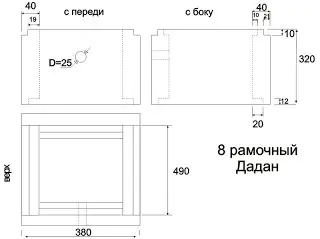
It is difficult to find drawings on the 8-frame hive Dadan, and they are not always needed. The design is considered non-standard. Amateur beekeepers make houses according to their preference, modifying some elements. As for the dimensions, when self-manufacturing, they rely on the following parameters:
- The length of the case is equal to the length of the Dadan frame plus 14 mm. A gap of 7,5 mm is provided between the side slats and the walls of the house.
- The width of the hive is calculated by the number of frames multiplied by their thickness. For an 8-frame house, the number 8 is multiplied by 37,5 mm. The last indicator is the thickness of the frames.
- The height of the module is equal to the height of the frame plus the height of the folds.
An 8-frame hive has a nest width of 315 mm. There are 7 streets, where up to 2,5 kg of bees are placed. For the winter, the house is equipped with a store, which contains 8 frames filled with honey with honeycombs with a total weight of 12 kg. In the nesting framework, the supply of honey reaches 1,5 kg. The total supply of food for the bee colony for the winter varies from 20 to 25 kg.
Assembly process
The manufacture of the Dadan hive begins with the preparation of the material. A dry board is cut with a circular saw to the required width and length, and subjected to grinding. At the ends cut out the grooves of the locking connection.
After preparing the material, they begin to assemble the 8-frame hive:
- The assembly of the body is carried out by connecting the prepared boards. Locks for tightness and reliability are lubricated with PVA glue before docking.
- The front and back sides of the hive body are assembled at the top with a wide board, and the narrow one is placed at the bottom. The side walls are assembled in the reverse order. Spacing of seams gives strength to the structure, prevents loosening. The ends of the walls (corners of the body) are connected with self-tapping screws. You can use pins or nails.
- A notch is cut out at the bottom of the hive.
- According to a similar principle, the bottom of the Dadan hive is assembled from the board. The assembled shield should fit snugly into the slats of the case. For a reliable connection with a cutter, a groove 20 mm wide is selected. Outside the hull, near the notch, a flight board is attached.
- Folds are formed on the inner walls of the body. The protrusions will play the role of stops for the hangers of the frame.
- The finished body is painted on the outside with oil or water-based paint.
Shops are made according to a similar principle, only of a lower height. The board can be taken with a smaller thickness – about 20 mm. Supports for frames are made of rails screwed with self-tapping screws from the inside of the walls of the case.
The roof is assembled universal, suitable for the store and the Dadan hive. The connection between the removable lid and the housing is left with a small play, but provides a snug fit.
Ventilation is provided between the cover and the body. There are two options:
- make a large upper notch 120 mm long;
- make a narrow upper notch, and cut through grooves on the sides and close them with a mesh.
Both ways are good. The choice is left to the preference of the beekeeper.
The roof is sheathed on top with a material that protects the hive from precipitation. Suitable sheet steel, preferably non-corrosive. Usually galvanized.
Keeping bees in eight-frame hives Dadan
Hive Dadan for 8 frames is approximately the same size as the Rutovsky building. Corresponds to the number of cells to be built. However, the design of Dadan is not able to provide all the advantages of a multi-hull hive. Dadan and root frames differ in height. In the multi-tiered hive of Dadan, they cannot be placed against the nest due to the large gap between the bodies.
In the 8-frame Dadan, due to the high height, the bees are reluctant to get to the store. They begin to deposit honey at the top of the nest frame. This place is the darkest. The egg-laying queen moves closer to the entrance. The uterus needs oxygen. If Dadan for 8 frames is made without a top notch, the queen will willingly work only from below. The brood from the top to the bottom bar will not work. There will be problems with transitions to the store.
You will have to make hives, canvases, roof liners yourself, calculate the optimal sizes, and come up with fixtures.
How to make a 10-frame hive Dadan
For a novice beekeeper, it is optimal to maintain the dimensions of a 10-frame hive per Dadan frame, and independently make a structure.
Drawings and dimensions of the Dadan hive for 10 frames

In general terms, the drawing of a 10-frame hive Dadan is similar to the design scheme for 8 frames. The only difference is the sizes.
Tools and materials
To assemble the hive, you will similarly need dry boards. Optimally suited pine, willow or linden. In the absence of these species, other wood with a light specific gravity will do. From the tool you need a circular saw, a grinder, a set of chisels, a planer, a milling cutter.
Assembly process
The sequence of assembling a 10-frame Dadan is no different from the previous model for 8 frames. The body and bottom are assembled from a cut board according to the drawing. The blanks are connected with a spike-groove lock with pre-lubrication with glue. It is desirable to make tapholes from above and below. The roof is optimally sheathed with aluminum sheet. Due to the lower weight of aluminum, the total weight of the 10-frame hive will decrease. Shops are packed last. The finished structure is painted.
Features of beekeeping in 10-frame Dadans
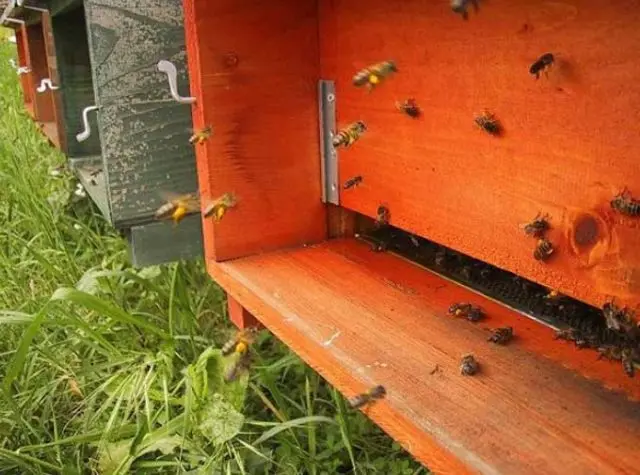
The Dadan hive is 10 frames better than its counterparts when it comes to keeping a young brood that has never wintered yet. However, for a developed strong family, such a house is small. The content of bees in 10 and 12 frame hives is the same. The first option wins only in less weight, which is convenient when carrying.
Due to the small nest of the 10-frame hive, honey bees are best kept in two Dadan buildings. The nests themselves are not reduced for the winter. If it is necessary to divide the bee colony for half a summer, some of the bees without a queen are sent to another small hive, where a new development will begin. The remaining bees with the queen will eventually fill the entire nest.
However, a 10-frame hive can be used for a strong family if the nest is in two buildings. Inside the common house there will be extreme feeding combs with honey and bee bread, 12 brood combs, 2 frames for new combs. Additionally, there is a spare empty space inside for two frames. It is used when strengthening the nest or breeding brood.
Do-it-yourself Dadanovsky 12-frame hive
To assemble a 12-frame Dadan hive with your own hands, the dimensions and drawings will need to be accurate. The design is oversized. Sometimes houses are made with a removable bottom to simplify cleaning.
Drawings and dimensions of hives Dadan 12 frames
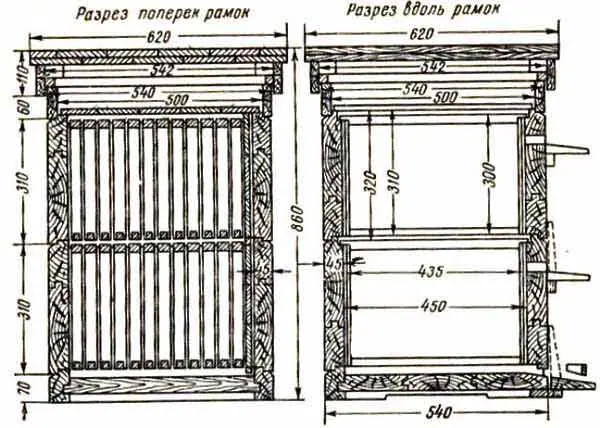
The diagram shows a section of a two-tiered Dadan along and across the frames. According to the drawing with dimensions, it is easy to assemble the bodies, bottom, cover and other elements of the hive.
Dimensions and drawings of the Dadan hive for 12 frames with a removable bottom
It makes no sense to repeat the drawing of the Dadan hive for 12 frames with a removable bottom, since it is identical. The same goes for sizes. The design is made according to a similar scheme, only the bottom is not thoroughly fixed.
Necessary tools and materials
Of the materials, a board with a locking connection is used. Additionally, you will need nails, self-tapping screws, PVA glue, sheet metal for roof upholstery. Tools needed for woodworking: planer, saw, milling cutter, chisels, hammer.
How to make a Dadan hive for 12 frames with your own hands
After grinding the boards with sandpaper and cutting into blanks of the required sizes, they proceed to assemble the house:
- Frame. The bottom is assembled in exactly the same way as the 8 or 10 frame Dadan. The boards are connected with a lock, having previously smeared with glue. The corner joints of the body are tightened with self-tapping screws or knocked down with nails.
- Shops are next in line. Inside all cases make stops for frames.
- When the stores are ready, they begin to manufacture the undercover part.
- For a notch, a hole is cut in the body, a landing bar is placed.
- The lid is made last. The shield is similarly assembled from boards, covered with galvanized top.
The finished structure is checked so that all elements can be freely separated and folded. The final part is the coloring of the hive.
Experienced beekeepers advise him to make it high up to 20 cm so that the family can freely accommodate. In factory-made Dadans, the subframe space is often 2 cm, which is very small for a strong bee colony.
Production of beehives for Dadan bees for 12 frames with a removable bottom

Dadan for 12 frames with a removable bottom is assembled according to a similar principle. The only difference is the lower part. The bottom is assembled from a board in the form of a pallet. The shield is inserted into the body with the help of folds, allowing you to quickly assemble and disassemble the Hive. The thickness of the removable bottom is 30 mm, and the strapping is 35 mm. With the help of inserts, an additional notch is formed. For the winter, they are replaced with other liners with smaller holes to keep the heat inside the hive.
Inside the house with a removable bottom, the subframe space can withstand up to 25 cm. The front part of the bottom protrudes 5 cm beyond the boundaries of the case, forming a landing board.
Features of keeping bees in 12-frame hives Dadan
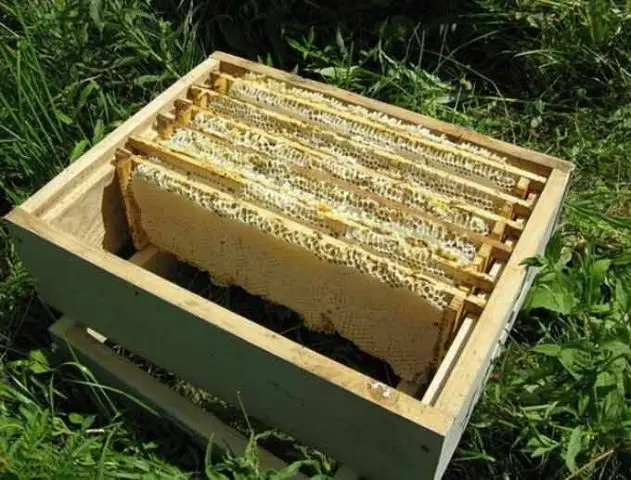
Features of caring for bees in 10 and 12 frame hives are the same. The design differs only in the difference in the number of frames. For a 12-frame Dadan, it is additionally worth considering the Lonin method, which is also suitable for its colleague for 10 frames.
The technology requires the following steps:
- the period from March to the end of April is used to increase the nest in breadth;
- from April to May, dividing bars are installed to help increase the nest down, but the brood part is not disturbed;
- in the upper sections, until May 15, queen cells are cut off, or they are allowed to hatch a new uterus;
- stores on the hive are building up before the start of the honey collection.
When all the honey is pumped out at the end of the season, the hive is prepared for wintering.
Which hive is better: 10 or 12-frame
According to the principle of keeping bees, there is no particular difference between hives for 10 and 12 frames. The first version of the house is easier to carry, it is more suitable for a weak family. The second version of the house is more stable due to its square shape. The store can be placed 2 weeks late, and it is allowed to place it perpendicular to the frames of the nest. The downside is the heavy weight.
Drawings and dimensions of the 14-frame hive Dadan
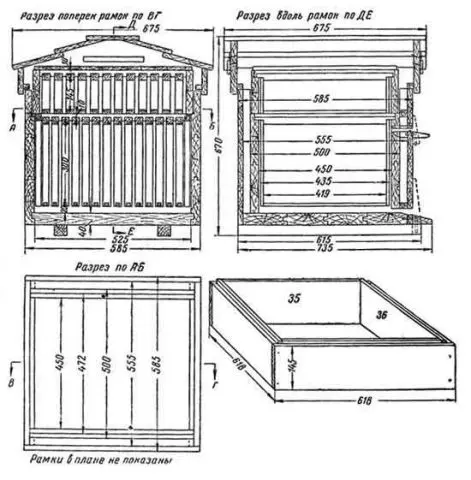
Dadan’s scheme for 14 frames is similar to its predecessors, only the increased dimensions differ. The hive has a number of advantages:
- Increased volume, allowing you to support a strong family, receive large bribes.
- In a bed with two bodies, you can expand the nests for a long time, which is beneficial with a two-queen method of keeping bees.
- When the family expands to 24 frames, it should not be restrained in development.
- With the installation of extensions on the 14-frame Dadan, the bees are loaded with work for a long time. The beekeeper has free time.
The disadvantage is the large weight and dimensions. Hives are hard to bear. If the apiary is nomadic, there are fewer houses on the platform.
16-frame hive Dadan: dimensions and drawings
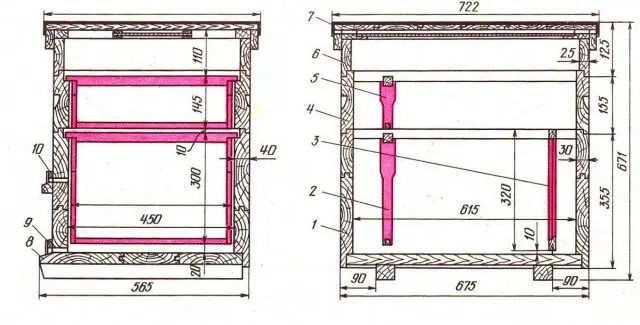
Dadan for 16 frames is a serious construction of a large mass. The bees are kept on a cold skid, placing the frames perpendicular to the notch.
The advantage of the design is:
- ease of inspection of the framework;
- improved nest air exchange;
- the stability of the hive with a large number of extensions;
- during the honey harvest, the installation of two stores is enough.
- in summer, during a small bribe in the heat, you can put stores 3 weeks later, which simplifies the solution to the swarming problem.
There are a number of disadvantages:
- nests develop slowly in spring;
- autumn build-up of bees occurs at the level of 12 frame Dadan;
- hard to bear;
- large dimensions complicate transportation, skidding in a box.
According to Siberian beekeepers, there is practically no problem with high humidity in large hives. For the sake of this, beekeepers are ready to forget about the shortcomings.
Drawings and dimensions of the dadan frame
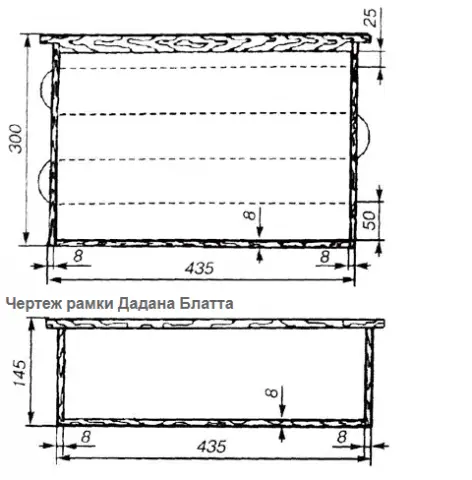
For all models of hives, the size of the Dadan frame does not go beyond the standards and is 435×300 mm. The structure is preserved in the same way. There are also half frames. They are used in store extensions. If we compare the dimensions of the semi-frame with the dimensions of the Dadan frame, then the width remains unchanged – 435 mm. Only the height has been reduced to 145 mm.
To insulate the nest for the winter, a diaphragm is placed inside the hive. The device resembles a frame, only sheathed on both sides with plywood. The interior space is filled with insulation, usually foam. Maintain the size of the diaphragm for the Dadan hive is the same as for the frame, but add 5 mm in height. In addition, the side strips are increased in thickness by 14 mm. The excess of the side elements in height and thickness allows you to tightly close the space between the frames and the side walls of the hive with a diaphragm.
Conclusion
Dimensions-drawings of the 12-frame hive Dadan can be taken as the basis for the design. The principle of making houses for a different number of frames does not differ. The scheme is left unchanged, but you just need to change the dimensions and proceed with the assembly.









